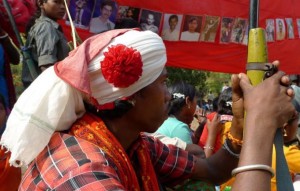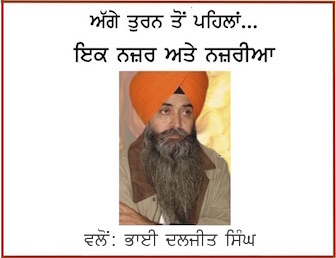Articles/Opinion
Incongruous placing of the Punjab Left with Tribal’s struggle in Sanjay Kak’s film
June 25, 2013 | By Sikh Siyasat Bureau
BY: Jaspal Singh Sidhu*
After much acclaimed film Jashn-e-Azadi (How We Celebrate Freedom-2007) Sanjay Kak has come out with ‘Maati Ke Laal’ (Red Ant Dream) which was screened in Chandigarh on Saturday ( 11 May, 2013) to an audience fairly dotted with left-leaning people.
The film begins with a scene of roaring heavy trucks with their headlights on ushering on the scene thereby signaling disruption of life and ultimate displacement of common people around. Thus, the scenes constitute a strong critique on ‘development agenda’ of the Indian government which displaces the local people, rob them of their natural endowments and resources, disturb their way of life, culture and century-old historical inhabitation. And, all this is being done in the name of achieving so called growth and development by the Indian Nation State. But, insatiate greed of the corporate houses whether located in the country and outside are behind this unmindful plundering of minerals and resources. The government with its coercive apparatus consisting of armed forces is at their (corporate ) beck and call. It is, no doubt, is neo-colonialism operation- a modern version of the colonial spree which Western rulers indulged in after the Industrial Revolution. Since India does have under developed world to plunder around, its rulers have turned to plunder the unprivileged and hapless people within the country.
The broader message of the film about the government’s ‘development agenda’ is okay. But choice of fighting forces which oppose implementation of the agenda, is misplaced and faulty, particularly what g Sanjay shows in Punjab palpably smacked of ignorance of the factual position and ground realty on the part of film maker. The tribal have been waging a fight for their existence which depends on preservation of their ‘Jal, Jangle and Jammen‘ from the plundering by the corporate aided and assisted by the government. In Chattisgarh the tribal got themselves armed with requisite ideology required to stand up to the oppressor and guns and weapons with open support of Maoists. The government has, too, launched and an organized ‘counter-insurgency’ operation in that area. As part of that operation, the government also raised Salwa Judam, and armed militia of locals in the area, which, of course, caused tremendous suffering and loss of life to the fighting tribal. With all this depiction, the film also shows that the tribal in Niyamgiri area of Orisha, too, fighting in their own way to preserve their flora and fauna ,culture, way of life and natural habitat from predatory inroads of the Bauxite mineral traders there.
But, right from the beginning, in the middle and at the end scenes from Punjab are inserted, rather, superimposed to depict the complete mechanization of the agriculture at the pattern of industry with a big machine harvesting the ripe wheat crop. These scenes make the background of the Communists hoisting red flags agitating holding public meeting at Khatkal Kalan, native village of Shaheed Bhagat Singh and marching through city-town bazaars. What is more incongruous that leaves a jarring effect is that agitating left workers are shown carrying the placards bearing Shaheed Bhagat Singh and Poet Paas’s portrait. Though, film is not a documentary as claimed by Sanjay, but equating Paas with Shaheed Bhagat Singh is certainly amounts to belittling of the latter who has become a legendary hero for waging an undaunted struggle against the British and for the manner in which he had embraced the gallows at the age of 23. In comparison, Paas cannot to raised that iconic stature for merely writing anti-establishment poetry since in practice and personal life he had lacked that relentless courage and moral loftiness which had been the hallmark of Bhagat Singh. And, Paas’s poetry has not become the part of the Punjabi folklore. Paas’s killing by the Sikh militants could be an outrageous act for the many but those killers did not constitute and represent the state and its establishment against which Paas’s poetry targeted.
Also, the choosing of a section of the Left to portray the fight for retrieval of what was Punjab before the advent of Green Revolution in 1960s showed a misplaced and selective approach of the film-maker. This section of the Left never fought for the preservation of Punjab’s natural resources , cultural and old way of life at par with those of the tribal who have picked arms to save their ‘jal , jungle and jameen’. The tribal fighting, in fact, amounts the struggle for the ‘right of self-determination’ which, even regionalism too, has no place in left’s lexicon in Punjab. Rather, fight for Punjab’s river waters, natural sources and saving of its religio-cultural freedom from being trampled upon has all along been an anathema to this section of the left. Taking up Punjab-based demands is a fundamentalists’ outcry for the left in Punjab which has been adopting political position on such matter which is analogous to that of the central establishment .And in the recent past the left used the same political phraseology which the government has used . How such section of the left could deserve to be depicted as fighting force for restoring Punjab’s pristine glory and against a nation state which spurns diversity and plurality and decimates the distinct religious cultural identities in its bid to homogenize India as a big corporate market . Punjabi writer Warryam Singh Sandhu underlines in his pamphlet on ‘Gadhrites’ that the communists had severed their struggle from the past culture and heritage and such practice failed them to strike roots in the soil of Punjab. In fact, the communists in Punjab represent an antithesis of what the participants of Gadhar Movement were. The latter took inspiration from the Sikh religion, culture and way of life and a sizable section of them were ‘amritdhari Sikhs’ . But the left abhors such dispensation.
In this context, portraying of the left in the film as a fighting force , even metaphorically, against the government and presenting them as inheritors of Gadhar movement is a glaring anomaly and travesty of the historical truth. Such distortion smacked of ignorance of the film maker .But the leftists who indulge in self-adulation, instead of much-needed self-criticism, would not be serving their cause either and such bigger- than-life depiction would be a delusory tactics.
* Author is a senior journalist, UNI (Retd.).
He may be reached at: jaspal.sdh (at) gmail (dot) com
To Get Sikh Siyasat News Alerts via WhatsApp:
(1) Save Our WhatsApp Number 0091-855-606-7689 to your phone contacts; and
(2) Send us Your Name via WhatsApp. Click Here to Send WhatsApp Message Now.
Sikh Siyasat is on Telegram Now. Subscribe to our Telegram Channel
Related Topics: Chhattisgarh, Jaspal Singh Sidhu, Punjab Left, Sanjay Kak





